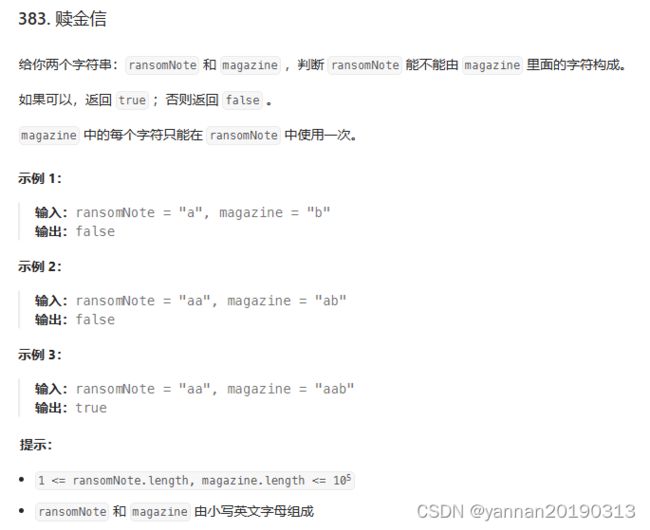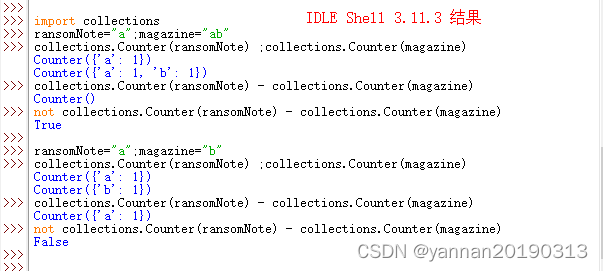【Python3】【力扣题】383. 赎金信
【力扣题】题目描述:
题解:
两个字符串ransomNote和magazine,ransomNote中每个字母都在magazine中一一对应(顺序可以不同)。
即分别统计两个字符串中每个字母出现的次数,ransomNote中每个字母的个数小于等于magazine中该字母对应的个数。
【Python3】代码:
1、解题思路:使用collections.Counter()分别统计两字符串的字母及出现次数,比较相同字母的个数。
(1-1)若某字母在ransomNote中的个数大于在magazine中的个数,则有元素在magazine字符串中不存在。
知识点:len(...):获取序列(字符串、列表等)的长度。
collections.Counter(...):字典子类,计数器,统计元素和元素出现的次数。
字典.items():返回可迭代的字典的所有键值对,键值对是元组形式 (键, 值)。
字典[键]:获取字典中键对应的值。也可给键赋值或修改值:字典[键]=值。
class Solution:
def canConstruct(self, ransomNote: str, magazine: str) -> bool:
from collections import Counter
if len(ransomNote) > len(magazine): return False
a, b = Counter(ransomNote), Counter(magazine)
for k,v in a.items():
if a[k] > b[k]:
return False
return True(1-2)两个计数器相减,即相同的键对应的值相减,若相减后仍有元素的值大于0,则有元素在magazine字符串中不存在。
知识点:collections.Counter(可迭代对象1) - collections.Counter(可迭代对象2):两个可迭代对象中相同元素的值相减,只返回结果值大于0的元素。
class Solution:
def canConstruct(self, ransomNote: str, magazine: str) -> bool:
from collections import Counter
if len(ransomNote) > len(magazine): return False
return not Counter(ransomNote) - Counter(magazine)注解:
2、解题思路:用一个字典记录每个字母的个数。
(2-1)字符串ransomNote中统计每个字母的个数,字符串magazine将字母对应的个数从字典中减去。若最终字典中有字母的值大于0,则有元素在magazine字符串中不存在。
知识点:collections.defaultdict(...):字典子类,若字典中某键不存在,则调用工厂函数返回默认值。
字典.values():返回可迭代的字典的所有值。
class Solution:
def canConstruct(self, ransomNote: str, magazine: str) -> bool:
from collections import defaultdict
if len(ransomNote) > len(magazine): return False
d = defaultdict(int)
for x in ransomNote:
d[x] += 1
for y in magazine:
d[y] -= 1
for val in d.values():
if val > 0:
return False
return True(2-2)两个字符串反过来统计,字符串magazine中统计每个字母的个数,字符串ransomNote将字母对应的个数从字典中减去,若减去后该字母的值小于0,则有元素在magazine字符串中不存在。
class Solution:
def canConstruct(self, ransomNote: str, magazine: str) -> bool:
from collections import defaultdict
if len(ransomNote) > len(magazine): return False
d = defaultdict(int)
for y in magazine:
d[y] += 1
for x in ransomNote:
d[x] -= 1
if d[x] < 0:
return False
return True3、解题思路:用一个列表记录每个字母的个数。以字母距离“a”的间隔作为下标。字符串ransomNote中统计每个字母总个数,字符串magazine将字母对应的个数从列表中减去。若结果中有元素大于0,则有元素在magazine字符串中不存在。
(3-1)知识点:[0]*26:即长度为26的元素都是0的列表,[0,0,...0,0]。
ord(...):获取字符的ascii值或unicode值。
列表[下标]:获取列表中下标对应的元素。也可修改下标对应的元素值:列表[下标]=值。
class Solution:
def canConstruct(self, ransomNote: str, magazine: str) -> bool:
if len(ransomNote) > len(magazine): return False
alist = [0] * 26
for x in ransomNote:
alist[ord(x) - ord("a")] += 1
for y in magazine:
alist[ord(y) - ord("a")] -= 1
for val in alist:
if val > 0:
return False
return True(3-2)知识点:itertools.chain(可迭代对象1, 可迭代对象2,...):返回一个迭代器,包含多个可迭代对象的所有元素。
enumerate(...):返回可迭代的所有元素下标和元素,元组形式 (下标, 元素)。
class Solution:
def canConstruct(self, ransomNote: str, magazine: str) -> bool:
from itertools import chain
n = len(ransomNote)
if n > len(magazine): return False
alist = [0] * 26
for i,x in enumerate(chain(ransomNote,magazine)):
if i < n:
alist[ord(x)-ord("a")] += 1
else:
alist[ord(x)-ord("a")] -= 1
for val in alist:
if val > 0:
return False
return True(3-3)知识点:itertools.zip_longest(可迭代对象1, 可迭代对象2, fillvalue=None):返回一个迭代器,将两个可迭代对象的元素按对应位置一一组成元组。所有元素遍历完,若其中一个可迭代对象没有元素了,可用fillvalue参数指定默认值来填充空缺,若没有指定fillvalue,则用None填充空缺。
class Solution:
def canConstruct(self, ransomNote: str, magazine: str) -> bool:
from itertools import zip_longest
if len(ransomNote) > len(magazine): return False
alist = [0] * 26
for x,y in zip_longest(ransomNote,magazine,fillvalue=0):
if x != 0: alist[ord(x)-ord("a")] += 1
if y != 0: alist[ord(y)-ord("a")] -= 1
for val in alist:
if val > 0:
return False
return True4、解题思路:将字符串ransomNote中字母去重,再遍历元素,比对字母在两个字符串中出现的次数,若所有字母在ransomNote中的个数都小于magazine中的个数,则返回True。
知识点:set(...):转为集合,集合中的元素不重复。
序列.count(...):统计元素在序列(字符串,列表等)中出现的次数。
all(...):判断可迭代对象(元组,列表)中的所有元素是否都为True。
class Solution:
def canConstruct(self, ransomNote: str, magazine: str) -> bool:
if len(ransomNote) > len(magazine): return False
return all(ransomNote.count(x) <= magazine.count(x) for x in set(ransomNote))
